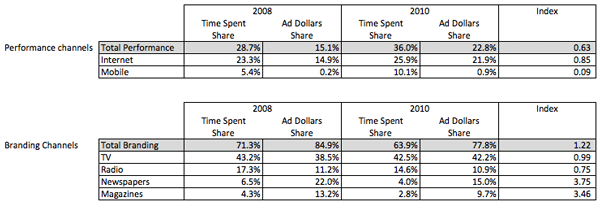Unlocking Ad Budget For Mobile: Why Rich Media And Video Will Be Key Factors In Ramping-Up Mobile Advertising Spend
by Ciaran O'Kane on 18th Apr 2012 in News


Paul Childs is co-founder and chief marketing officer at global mobile advertising marketplace, Adfonic. Here Childs takes a look at some of the factors that will drive growth in mobile advertising spend.
Advertisers need compelling reasons to shift budgets across media channels; below are some points for consideration that advertisers need to factor into their thinking and decision making process.
Mobile advertising spend is growing fast, very fast in fact according to the mobile ad spend reports for 2011 from the IAB US, UK, and Spain. In the UK alone, mobile ad spend grew 157% year on year from 2010 to 2011 at an accelerated rate. However, mobile advertising remains a nascent market with enormous potential to exceed online ad spend in probably half the time. Let’s explore some of the opportunities that exist today.
Proportion of time on mobile devices not aligned with ad dollars
Despite the huge buzz around mobile advertising at the moment, mobile still accounts for a small portion of total ad spend. A study by eMarketer (see below) showed that in 2010, time spent on mobile devices accounted for 10.1% while spend only accounted for 0.9%. The interesting observation from the table below is the disproportionate spend on traditional media whilst media time is decreasing – particularly the over index on Newspapers and Magazines. Some industry experts have estimated time spent on mobile devices in 2012 will reach 20 – 23% with ad spend remaining relatively unchanged at the 1-2% level. This clearly demonstrates that advertising dollars are not being spent where consumers are increasingly spending most of their time. However, we are a seeing shift in the right direction, albeit more slowly given the data points below.

Consumer behaviour is changing fast; we will soon be spending more time on mobile than desktop
As at the end of 2011, there were approximately 500 million Android and iOS devices collectively across the globe. In the top 20 countries with the highest smartphone penetration, the share of these platforms ranged from 60% to 90%. Android and iOS devices have been a game changer in how we use mobile phones. The uber-sleek design, coupled with the now superior touchscreen interface has created a new, slick browsing experience for consumers. Add to this the vast number of apps available across the growing number of app stores (Apple, Google, Amazon, etc.), and you can understand why consumers admit to being addicted to their devices.
A recent study by Flurry showed that we now spend one third more of our time on mobile apps than desktops. That’s a significant contrast to 18 months ago when the reverse was true. Other interesting data points came from studies carried out during the Superbowl in February 2012. The first notable stat showed that 50% of viewers accessed their phone 10 times or more during the game and secondly, that 33% of viewers watched the entire game with their mobile device in their hand. It stands to reason that with these stats in mind, the big brands spending millions of ad dollars on TV advertising during the Superbowl may, or rather should, be considering an integrated approach for their Superbowl ad strategy next year that includes mobile.
Options for advertisers on mobile
Given the above, the obvious takeaway from the mobile advertisings status quo is the need to shift away from the old school static banners on mobile devices to more engaging consumer experiences. Rich media mobile ads, that contain an element of interactivity within the ad, give advertisers a blank canvas to create superior consumer journeys that can closely align with brand values and experiences. This is fundamentally what digital and traditional agencies have been waiting for before embarking on mobile advertising as a mainstream media channel option for advertisers.
One aspect of rich media is video, and Adfonic recently launched its end-to-end integrated video mobile advertising product. The consumer experience of tap-to-video opens up broadcast media to mobile opportunities. With this product, advertisers can re-use commercials or shorts created for online, cinema or TV, on mobile. During beta testing we were running commercials for film studios ranging from 10 seconds to 30 seconds with the 30-second version generally outperforming the shorter clip. In practice, by tapping on a banner (ranging from the standard size 320 x 50 to full page) on an Android or iOS device the native video player is seamlessly initiated on the device, and the commercial starts playing. At any point during the video the user can tap on the “Done” button and immediately return to where they were within the original app or mobile site. This seamless integration between mobile site and app browsing and mobile advertisements provides consumers with a simple and intuitive way to switch between the two experiences.
Moreover, Adfonic’s end-to-end integrated video mobile advertising product delivers real-time video viewing metrics that are fully integrated into the advertiser campaign reports, giving advertisers live snapshots from banner impression to consumer clicks to viewing quartiles to viewing engagement score. This example of a seamlessly integrated consumer journey, presents advertisers with new options to reach incremental audiences via a relatively (for now) untapped channel that we, as consumers, are spending significantly more time connected with.
Integrated marketing communications
For advertisers considering mobile as an additional channel to their marketing communications plans, the new creative options offered by rich media and video provide an easier transition to an integrated approach (which includes mobile). For innovative advertisers that create engaging TV commercials, mobile now offers closer alignment between consumer experiences across channels. When it sinks in for advertisers that mobile apps and sites now generate larger audiences than most popular prime-time TV shows, a made-for-TV commercial can be re-used and delivered to consumers using iOS and Android devices nationwide across the ad networks. Let’s not forget that few advertisers (if any to be honest) today are successfully executing integrated marketing communications, and for those that do get it right, it can hold the path for competitive advantage and access to untapped audiences.
Metrics: Talking advertiser language
Metrics for rich media fall into two distinct areas: hard metrics (such as click volumes and click through rates) that digital marketers live and breath on a daily basis; and soft metrics (such as product awareness, purchase intent and product recall), a metric typically used at more established digital and traditional agencies. With both video and rich media, research companies, like Nielsen and On Device Research, are now tapping into effectiveness studies to measure the softer elements of campaigns and comparing these with similar metrics across other media channels. The effectiveness studies that have been made public are demonstrating significant uplift when using rich media compared to static standard mobile ad banners and positive results on metrics like brand recall. However, more research and case studies are required to significantly drive up rich media mobile advertising spend.








Follow ExchangeWire